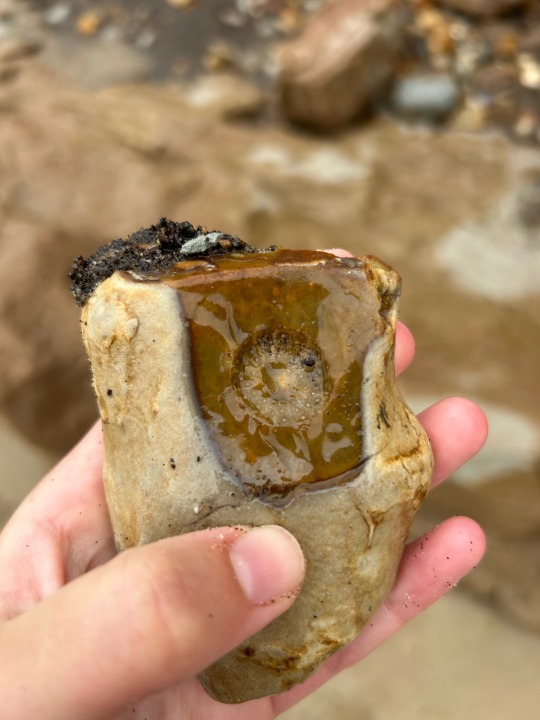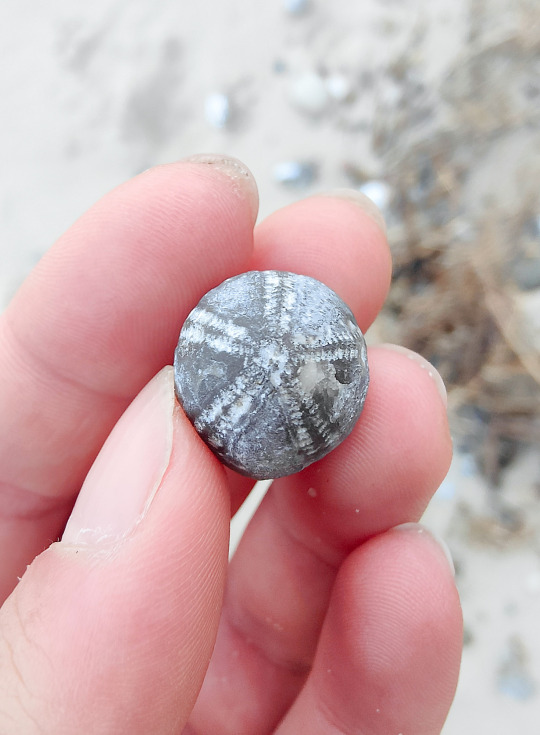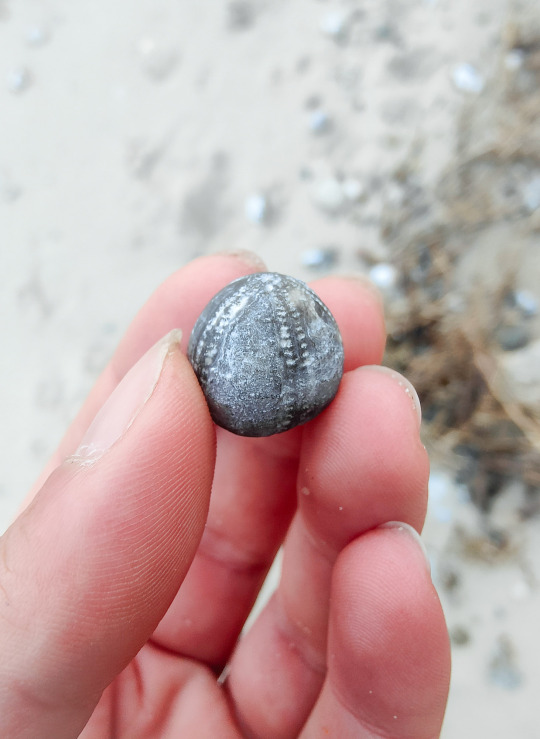#Echinoid
Explore tagged Tumblr posts
Text




More variety echinoids of different ovale forms, in flint colors on the rock plates.
They looks like dry crusty crumble cookies.
#fossils#fossil collecting#geology#echinoids#echinoid#fossils 2024#flint fossil#flint rock#chert#collecting rocks
102 notes
·
View notes
Text




The new wave of echinodem. Some in ovale, brown with little remicent of their distant shell pattern. Found great ones in good condition.
The two orange broken parts in orange flint.
Some have clear pattern, others are chunky.
And the other three in gray, with outstanding intact one in darker gray.
All are good example to shown of the varity to finding and for id.
#fossils#geology#fossil hunt#echinoids#echinoid#echinoderm#fossils in germany#fossils 2024#fossil collecting#fossil friday
23 notes
·
View notes
Text

Regular echinoid fossil I found today. It is from the Vectis formation and is around 80 million years old.
See the perfect five-fold symmetry as opposed to the irregular echinoid I posted yesterday.
#fossils#echinoderm#echinoid#palaeontology#cretaceous period#late cretaceous#special interest#actually autistic
9 notes
·
View notes
Text

Fossil Sea Urchins (echinoids) from the Cretaceous period, discovered along my Life path.
©Robin Fifield.


#robin fifield photography#photographers on tumblr#sea urchin#echinoid#fossils#geology#animals#fossil friends
66 notes
·
View notes
Text
Beachcombing - A Fairy Loaf
I found this lovely flint fossil echinoid on the beach between Marske and Redcar. The fossil is smooth to the touch and heavy in the hand, beautiful dense flint with an unmistakable five pointed star on its upper surface, it’s a first for me. Fossil echinoids are not uncommon finds in areas with chalk bedrock but this is the first example that I have found on our beaches. Fossil echinoids have…

View On WordPress
5 notes
·
View notes
Text



Buscando erizos de mar en pozas intermareales por la península de Cavancha, Iquique.
1 note
·
View note
Photo

Rare Cretaceous Echinoid Fossil - Tylocidaris clavigera with Spines, Upper Chalk, Thanet, Kent, UK - w/ Certificate
This rare fossil specimen of the echinoid Tylocidaris clavigera, complete with spines, originates from the Upper Chalk deposits of Dumpton Gap, Thanet, Kent, UK. Dating back to the Cretaceous period, approximately 85 million years ago, this fossil offers a fascinating look into the marine life of Britain’s ancient seas. Each fossil in our collection is 100% genuine and includes a Certificate of Authenticity, ensuring its historical and scientific value.
Tylocidaris clavigera is known for its distinctive, club-like spines and rounded body, which served as protection from predators and allowed it to move along the seabed. This beautifully preserved specimen shows both the echinoid and its spines in remarkable detail, capturing the characteristic texture and form of this fascinating species. Fossils like this are highly prized for their unique appearance and the insights they provide into ancient marine ecosystems.
Species: Tylocidaris clavigera (extinct echinoid)
Origin: Dumpton Gap, Thanet, Kent, UK
Geological Period: Upper Chalk, Cretaceous (~85 million years ago)
Authenticity: 100% genuine, with a Certificate of Authenticity provided
Condition: Excellent preservation with visible spines and detailed echinoid structure
Scale and Sizing: Scale cube in photos represents 1cm; please refer to images for full size details
Specimen Specificity: The photo shows the exact specimen you will receive
This Tylocidaris clavigera fossil is a carefully chosen addition for collectors, educators, or anyone interested in prehistoric marine life. Its distinctive form and remarkable preservation make it a standout piece, offering a unique glimpse into the ancient seas of the Cretaceous. Add this rare echinoid fossil to your collection today and own a piece of natural history!
#echinoid#sea urchin#fossil#fossils#dendraster giblesi#echinoid fossil#pliocene period#echinoderms#genuine specimen#fossil specimen#fossilized echinoid#sea fossil
0 notes
Text
instagram
#Rare Quality Chiastolite Cabochon 100%Natural Chiastolite Loose Gemstone Pear Shape Handmade Polished Chiastolite For Jewelry Making#chiastolite#minerals#fossil#iran#crystalhealing#geology#crossstone#iranminerals#of#fineminerals#collctions#echinoid#miocene#pygurostoma#gastropod#schumk#fossilien#kristalle#mineralien#crystal#zagros#paleontology#ammonite#clupeidae#fossils#reiki#chakra#concretion#collection
0 notes
Text


Fossilised echinoid (sea urchin), in pristine condition. He's also tiny.
6 notes
·
View notes
Text




Like the pic before last evening yesterday, found this flat top piece of an brown echinodem fossil top, with flat cut grey open underside. Without many other stones here.
Then on the route back the half piece end of an new aulaxinia sulficera sponge with this wave pattern, was on the back walk from the stone road.
#fossils#fossil collecting#collecting rocks#geology#rocks#flint fossil#echinoid#fossils in germany#fossils 2024#sponge fossil
82 notes
·
View notes
Text


The new finds from the today trip to the mentioned stone road & one location with piles.
They are sponges aulaxinia sulficera - the in lengt two again and the round stone with the mold on it. I have already an specimen like this in dark flint.
Then the in half round open chert/ flint cut sponge with the inner pattern.
The first like this with an clear pattern of some struckture shown!!
And an absolutly tiny echinoid core, if you zoom in you can see the little reminicent pattern.
At first without cleaning, i was thinking it was an fungus on it, but afterwards the pattern is in the flint, likely calcite.




#fossils#geology#fossil hunt#fossil collecting#aulaxinia sulficera#sponge fossil#fossils in germany#fossils 2024#echinoid#fossil friday#fossil
15 notes
·
View notes
Note
Have you ever accidently dropped a fossile?
haha omg i used to work in collections and let me tell you. YES. so many echinoids and mollusks… thankfully though they’re not hard to glue back together so it’s never much of an issue!!
#i think if i dropped a drawer full of fossils i would’ve kms on the spot#i have nightmares about that#but i’m super super careful with them usually!! plant fossils especially!!!#and older specimens. sometimes the glue has gotten all dry and they’ll go to pieces#talk#ask
58 notes
·
View notes
Text
Various Uses for Fossils in Magic from Wisht Waters by Gemma Gary
"Sea fossils, as well a guarding against drowning, had other protective uses. The fossils of sea urchins, or Echinoids, were employed for a variety of protections. Upon these fossils, one might find a star-like pattern, very reminiscent of the 'daisy-wheels', which one might find inscribed into the timbers and masonry of ancient buildings, most likely for apotropaic purposes. Their folk names include shepherd's crowns, thunder stones and fairy loaves. They protected against thunder, evil spirits and witches, prevented milk turning sour, and in common with other fossil amulets, they sweated in the presence of poison. As 'fairy loaves' they might be used to ward off supernatural interference from the baking process, and to ensure an abundance of bread."
pg. 104
"Belemnite fossils, from an extinct squid-like creature, were known as thunderbolts, and were thus kept as charms to protect against lightning. Once believed to be the tongues of ancient serpents, fossilised shark teeth were one of the fossil amulets against poison"
pg. 104
"Rings of stone, formed from the fossilised stems of the sea-lily were known as St Cuthbert's Beads, as were worn as amulets against evil influences."
pg. 105
"The 'Devil's Toenail' fossils were carried as charms against rheumatic pain, and they were powdered to be used in the treatment of soreness of the back in horses."
pg. 107
"Various accoutrements of the sea witch's divinatory work may be seen in the Museum of Witchcraft. Here we find that belemnites were employed by a Newlyn sea witch named Nancy. She would read the fall of her 'sea stones' to make predictions for fishermen. Perhaps their traditional association with lightning gave belemnites the virtue to make predictions regarding storms and changes in the weather?"
pg. 108
[...] There have been many ways to bless, consecrate and 'sain' water, thus rendering it more potent and useful within various rites and magical operations. This might be achieved by steeping or immersing charmed items within the water, or else allowing water to flow or be poured over such an item. These may include charm-stones, fossils, flints, or the metals gold and silver.
pgs. 115-116
"Ammonite fossils were also employed as charm stones to cure cattle in 17th century Scotland. They were known as 'cramp stones' because cattle afflicted with cramp would be treated by being bathed in water in which a 'cramp stone' had been steeped for a number of hours."
pg. 122
#witchcraft#witchblr#witch#magic#correspondences#fossils#protection magic#protection#weather magic#weather#weather witch#healing#healing magic#healing witch#divination#blessing#consecration#water witch#sea witch#ocean witch
121 notes
·
View notes
Text
How I do my job and accommodate my disabilities.
So, I have the best job in the world. I'm a fossil tour guide and basically walk around the beach with people talking incessantly about my special interest and they are actually interested and pay (extremely good) money for it. I'm living the dream guys!
As awesome as my job is, there are a few challenges due to my disabilities. Luckily, I have found ways to accommodate myself so both me and the customers all have a great time. I've decided to split this list up by disability rather than by different aspects of the job so if you have one of the disabilities that I mention you can just look at the bit that is relavent to you to see if any of the things that are helpful to me are helpful to you. If you have any other suggestions of different things to try, please put it in the comments!
Autism:
To be honest, the palaeontology field is full of autistic people so I really don't stand out. When people book a fossil tour, they expect the tour guide to be a little quirky, so I do have a bit of leeway for seeming socially awkward without too much judgement.
I don't really pick up the hint that someone isn't having fun any more, so when the weather is bad I make sure to tell people at the beginning of the tour "I know it's really (insert unpleasant weather situation here) today, so if at any time this stops being fun for you, we can always head back early, just please directly tell me 'I'm not having fun any more, can we go?' because I'm not great at picking up hints." If the family are from the UK, I sometimes make a joke about them not being my hostages, but I avoid this with foreign families because that kind of humour doesn't always land well with other cultures.
I have visual materials to help keep my talks on track and to better explain the points that I'm trying to make. I also keep my initial talk pretty similar every time so I don't have to think of the words off the top of my head every time.
I make sure I give clear factual answers to questions that give both the technical terms and a simplification to all age groups e.g."That is a fossil echinoid which is the scientific name for a sea urchin." This avoids having to guess the person's level of prior knowledge and avoids me being overly technical or coming across patronising.
I try to limit my work to around 3 hours per day to avoid getting overstimulated.
Deafness:
I always make sure to tell people about my deafness right at the start of the tour and tell them how to accommodate me. I try to make it lighthearted I'll say it like "Just so you know I'm Deaf which means I can't hear well. If I look like I'm ignoring you, I'm not, I just can't hear you. Please tap me or wave at me to get my attention and make sure to look at me when you're speaking so I can understand you." Some people just ignore the instructions, but at least then they know what they're supposed to be doing, and it normally works out okay.
I have a cochlear implant which helps me a lot, but is vulnerable to wet and windy weather. I use EarGear covers on my processor to block out the wind noise and to protect it from moisture. It works pretty well, but isn't perfect.
I probably would benefit from an interpreter, however my work schedule is pretty flexible and often there are last minute bookings, also there aren't many interpreters near where I live so it would be virtually impossible to find one, so I make do without and it seems to be working okay for me.
Balance and Mobility (HSD and balance disorder):
Luckily my hypermobility is pretty mild so I'm able to weight bear fully on both legs and climb stairs etc.
If I'm going to be walking/standing for over 1 hour, I use knee supports to help prevent knee pain. I use the ones that are thin and elasticated tubes (kind of like a sock) rather than the velcro ones because they look more sleek and I find them more comfortable, also I only need fairly light support. I recommend using the lightest support that is reasonable for you to avoid weakening your joints. If you're not sure, speak to a professional.
I use an ergonomic backpack with padded straps and try and keep my kit as light as possible. I always make sure to carry it over both shoulders to avoid an uneven load on my body. I used to just use any old backpack and cram it full of examples of every single fossil you could ever find. Don't do that. You're not on SAS who dares wins.
Trekking poles. (In my opinion) The most underrated mobility/balance aid out there. Does it make me look like I think I'm scaling Everest? Yes. Does that fact make me feel ridiculous? Yes. Am I very grateful for them when I lose my footing on a pebble bank? Also yes. Most of the time I use one pole just for balance so I can keep a hand free, but I do have two, just in case. It also allows me to point at things without bending down so much which helps with my vertigo issues. If you are considering whether you could benefit from a mobility aid for your balance, especially if you're often on uneven surfaces, I would urge you to try trekking poles. You can use two at a time for extra support, they're gentler on your wrists than a crutch or cane and they come with the option of rubber or metal tips depending on the surface you're on.
Here is my relatively comprehensive guide to how I do my awesome job. If you have any questions or you would like to suggest something that you've found helpful, please leave a comment.
#actually autistic#disability#actually deaf#autism#actuallyautistic#hard of hearing#sensory disability#mobility aid#hypermobility#neurodivergent#neuropunk#cpunk#cripplepunk#disability accommodations#ehlers danlos syndrome#hypermobile ehlers danlos#hypermobile eds#cane user#deaf#cochlearimplants#hearing aids
40 notes
·
View notes
Text

Bahamas 60 cent King Helmet Snail Shell postage stamp (1996).
This postage stamp was issued by the Bahamas on 2 January 1996 (Scott Catalogue # 859). It is part of a set depicting seashells. The 60 cent value shows a king helmet snail shell, Cassis tuberosa (Family Cassidae). Cassid snails prey on echinoids and other echinoderms in shallow-water marine sandy substrates and reef facies in tropical to temperate settings. Classification: Animalia, Mollusca, Gastropoda, Cassidae Info at: en.wikipedia.org/wiki/Cassis_tuberosa
18 notes
·
View notes
